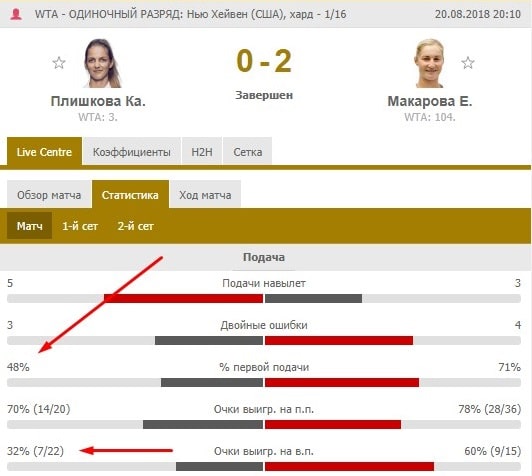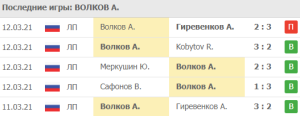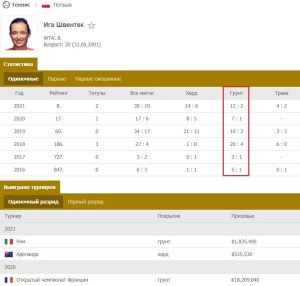
The US Open is the last Grand Slam of the tennis season, it takes place on hard and starts at the end of August. The tennis season begins with hard, then clay follows, then tournaments are fleetingly held on the grass and again end with hard. The features of the US Open are two main points:
- hard is the favorite surface of the overwhelming majority of tennis players, those who have badly failed before this on the ground and grass are trying to catch up
- this is the last opportunity this year to win the Grand Slam Cup, many tennis players are approaching this tournament at their peak
Given these circumstances, it is worth considering how to place bets on the competition in question.
Content
- Tournament features
- Training of tennis players
- Key characteristics of participants
- A large number of Americans
- How to prepare for the tournament?
- How do I bet on a tournament?
- Summing up
Tournament features
When determining the tactics of the game, there are three main features to consider.
Training of tennis players
Wimbledon ends in mid-July, and tennis players are immediately preparing for the next Grand Slam tournament, starting in 6 weeks. During this short time, several major hard tournaments take place at once: the Canadian Open (Montreal, Toronto) and Cincinnati, which is taking place in the USA.
All three tournaments allow the athlete, after the ground and grass, to get used to the peculiarities of the hard and to acclimatize well. These tournaments should be closely monitored.
You can find out about the features of betting on tennis tournaments of various levels and ratings in a special review.
Key characteristics of participants
In clay competitions, the physical form of the player comes first, his ability to play near the net and the ability to punch powerfully and accurately with both hands. On grass, the fastest surface with strong ball rebound, a powerful, accurate serve plays a decisive role, with a good level of play in general. On hard, universal surface, all characteristics of a tennis player play a key role:
- Precision and strength of the first serve;
- Current fitness;
- Game level: the ability to play in strong winds, during light rain, play with frequent breaks, sometimes lasting more than 10 hours, etc.
If one of these indicators is at a low level or two indicators are characterized as average, it will be impossible to achieve high results on hard.

These indicators on any surface will lead to failure: 48% of the first serve, when a tennis player sends the ball to half of the opponent at high speed, when it is difficult for him to take a fast-flying ball and seize the initiative, this is extremely small. At the same time, it is worth paying attention to 32% of the points won on the second serve. This indicator well characterizes the current form of a tennis player.
During the second serve, the ball flies to the opponent's half at a low speed, the player focuses not on speed, but on accuracy, in order to prevent a double mistake. All this allows the opponent to comfortably take the serve and seize the initiative, and here the level of play comes to the fore, where 32% indicate a low level. There is one more indicator that well reveals this characteristic.
27% of the points are won on the opponent's serve, this is a disastrous figure.
These are all key characteristics of the current form of the player, they are simply failures. If a tennis player immediately after Wimbledon demonstrated such indicators, and then they began to increase sharply, then one should expect a strong performance from him in the USA. If a tennis player before the Grand Slam tournament took part in 3-4 competitions and his performance “spun” around such numbers, then he will face an unambiguous failure.
A large number of Americans
This is an important point. Grand Slam tournaments take place in turns in Australia, France, England and the United States. In the first three tournaments, not so many TOP-100 representatives from among the local players take part. The exception is the men at Roland Garros, where often about 10 men represent their country, France, and play at home. Their number goes off scale only in the United States. If we take women's tennis, then often the number of American women exceeds the number of 10 out of the TOP-100. For men, this figure is slightly worse, but also 7-10 players with a US passport play at the Open of this country.
The USA is massively represented in the top competition by local players. These are strong athletes, many of them are in the TOP-50. When such players approach the tournament in good shape, they can achieve high results based on overwhelming motivation.
Immediately five tennis players from the USA were in the TOP-30 shortly before the top tournament, 7 American women were in the TOP-50.
Their performance after Wimbledon should be closely watched.
How to prepare for the tournament?
Bettors find it much more difficult to prepare for this tournament in comparison with Roland Garros and Wimbledon. If in England (Wimbledon) a player is not in the best game form, but he has a powerful and accurate serve, he can easily outplay an opponent with a good game form, but with a bad serve.
A lot depends on the filing as a whole, there are even separate betting strategies, sharpened exclusively for it. You can get acquainted with such a strategy in a separate review.
On clay, serving no longer plays a colossal role, although it is important, here the general level of play comes first. On hard everything is important, therefore it is necessary to monitor all indicators. Bettor cannot track the current form of all athletes, so he should keep an eye on the following group of players:
- TOP-20;
- Participants in the semi-finals and finals of previous tournaments (it will be useful to carefully study the quarter-finals as well);
- American tennis players from the TOP-50 (if possible, the TOP-100).
What to look for has been described above. Sometimes young bettors make a gross mistake.
This is how the Czech player, Karolina Plishkova, played in 2018. After Wimbledon, Plishkova played in three tournaments on hard, where she suffered three defeats out of five matches. Many young bettors may think that the Czech played extremely poorly in these competitions, so she had to fail in the main tournament in the USA. But in reality, everything happened the other way around: Carolina managed to reach the quarter finals, where she lost to an American, Serena Williams.
The American in general prepared herself like this for the Grand Slam held at home, and managed to reach the final.
In lost matches, it is important to look at exactly who the athlete lost to. Plishkova was defeated by really powerful opponents. You can take note of these defeats, but this does not mean that she is in bad shape. Now, if the Czech played terribly, for example, with the 150th racket of the world, which is not in the best shape, this indicator could be taken into account.
How do I bet on a tournament?
These are the results of 2018, where you can see how three American women made their way to the quarterfinals in the women's tournament, two representatives of the United States reached the semifinals, and Serena Williams played in the final.
In men's tennis, the results are not so impressive, but it must be understood that US men in general perform significantly worse than women on the world stage. If we take the results of 2018, then immediately 7 Americans made it to the 1/32 finals, two of them made it to the 1/16 finals, only one in the 1/8, and in the quarterfinals there were no US representatives anymore.
The main thing to know is that when a representative of the United States meets an approximately equal opponent, under certain conditions it is worth playing on his side.
Considering all the material presented above, the bettor should, within the framework of the sparring of the top tournament, look for unreasonable strong loads and obvious distortions. Let's look at a few examples of how to do this.
This is a classic case when a player gave his emotional strength in two tournaments and was eliminated outright in the first round of the main draw of the third tournament. The Romanian tennis player performed powerfully in Montreal, winning this tournament, then immediately reached the final in Cincinnati. The Romanian spent 10 friendly matches in 11 days, where there were a lot of top rivals. In such a situation, it is imperative to play against such a powerful player in the third competition in a row.
In the first round of the US Open, the Romanian was heavily loaded, but the rival won, when it was possible to play safely on her large plus handicap in games, when at F2 (+6) they gave 1.8-1.9. This is an example of how you can prospectively play against a load. Experienced bettors clearly noticed Halep's powerful move and played against her in the first round, having waited for such a load.
The movement of the coefficients in tennis in general must be monitored as closely as possible, because with proper use and timely rates, they can significantly increase profits. How to do it – read here
But skeptics may argue: “What about the Dutchwoman Bertens, who managed to beat Halep in the Cincinnati final and thereby win this tournament before the Grand Slam?”
Bertens flew to Montreal in the quarter-finals. Then she managed to win in Cincinnati and immediately played well in the first two rounds, but later she was eliminated as well. The Dutch woman did not have emotional fatigue before the top tournament, many players successfully perform in the next tournament, having won the previous one. Problems start after winning two tournaments in a row.
We again recall the Czech woman, Plishkova, who played not the best images in three tournaments on hard before the Grand Slam. But the losses followed with a good game from powerful opponents. Inexperienced bettors did not take this factor into account and put powerfully against Plishkova in the 1/64 finals in the US Open, when she got a not the most difficult opponent.
Once again, bettors succumbed to the results of the last sparring, not fully evaluating all the factors. This led to another opportunity to play promisingly in opposition to the bettors' opinion and to bet on a small, due to the load, negative head start of the favorite, but at a good coefficient.
Summing up
Each Grand Slam tournament has its own characteristics, the order of preparation for each of the four competitions goes in different ways, but the strategy of the game during the tournament itself is the same: the game is skewed and against an unreasonable load.


